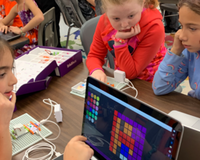There are countless reasons to set up a robotics lab in school. To name just a few: they provide opportunities for hands-on learning, they encourage teamwork and creative problem solving, and they allow students to develop valuable skills that translate to real world career opportunities. On a fundamental level, integrating robotics into education also gives students more options to explore their interests outside of classic extracurriculars.
Adrienne Emerson, Education Content Manager at Sphero, sees this as a key reason for creating a robotics lab at school. “Everyone deserves a place to explore their interests in grade school, whether it’s sports, band, theater, or something else,” she says. “Today, robotics is starting to become as prevalent as these topics in schools. One of the best arguments that people use in favor of robotics is that it's a sport where everyone can ‘go pro’. We know that with sports, band, and theater only a small portion of students ever make it professionally, but everyone in a robotics group has the potential to take their skills into a professional setting, like engineering.”
5 Things You Need to Build a Robotics Lab
As you or your school plans to set up a robotics lab, here are five crucial things you’ll need to get started:
Space
The first thing you need when setting up a robotics lab is space for it. It’s rare that a school will already have a dedicated room for this extracurricular, so you might need to get creative. If you have an underutilized or disused classroom, it can be repurposed for robotics. Alternatively, you can reorganize existing spaces, like a computer room or library to include a designated robotics area.
Ideally, the lab will occupy a permanent and ample space, due to the need for a work area (with tables and equipment) and practice zone. As Adrienne points out: “Robotics labs typically require more open space than a typical classroom to fit larger tables to build on, the tools and equipment needed, and a space to practice which often comes in the form of a mat or field.” That said, if your school doesn’t have a ton of extra space, you can set up a smaller robotics lab with less equipment and more compact robotics kits. If there isn’t a permanent space available, you can also look into making your equipment portable and use the cafeteria, gym, or atrium when they aren’t being used!
Robotics equipment
Once you have a space available, the next step is to invest in robotics equipment. There are a ton of different options out there, so it’s important to think about what your objectives are, what resources you have, and what your students are interested in. If programming is a key focus, there are hands-on programmable robots, like the Sphero BOLT robotic coding ball, that let students create code and see the results of their work in action. In labs where design and engineering are a focus, the Sphero Blueprint Build Kit lets students solve challenges by building mechanical designs from a variety of components.
If resources are available, schools can even invest in additional equipment like a laser cutter or a 3D printer, which give students the tools to flex their 3D design chops and create robots from scratch. “A 3D printer is always a great addition to any lab, and a laser cutter is even better,” says Adrienne. “But again, this all depends on your chosen robotics platform, because some may not require additional tools or equipment.” These quick prototyping tools are coming down in price making them affordable and accessible for more schools to purchase and allow students to rapidly create their own designs.
Auxiliary equipment
In addition to the robotics kits and equipment, a robotics lab also needs auxiliary equipment, like computers, a standard toolkit, workstations, adequate power supply and outlets, as well as safety supplies. If you’re coding, you want to ensure that the computers in the lab are compatible with the robotics platforms you are using. A robotics lab also needs computer desks (seated or standing) and worktables, where students can build their robots.
Some educators integrate robotics lessons with elements of shop class, showing students how to use tools—like drills, hammers, saws, etc.—with the goal of building robots. In these cases, proper storage and safety equipment, like goggles, are required. Proper ventilation is also a consideration in a robotics lab, particularly if you have a 3D printer or laser cutter in operation.
Teacher training tools
You can have the best robotics equipment in the world, but if you don’t have teachers that know how to use it, students will inevitably struggle to get going. It’s therefore important to encourage teachers to get involved in the robotics lab and give them the tools and resources they need to teach students new skills.
At Sphero, for example, we not only create programmable robot kits, but we also have a whole educational ecosystem that teachers can take advantage of. Resources like self-guided training courses and virtual seminars enable teachers to upskill themselves and gain an understanding of robotics, which they can share with their students. Ultimately, having educators on board with a robotics lab and empowering them with knowledge and skills will help foster enthusiasm among students and make learning all the more rewarding.
Students!
Arguably the most important factor in creating a successful robotics lab is a group of dedicated students. Fortunately, the dynamic environment and hands-on learning that robotics allows are appealing to many students, so it shouldn’t be a problem to generate some interest. Students generally enjoy being able to see the results of their newly acquired skills in a tangible, meaningful way.
Also, robots are fun.
Once your school’s robotics lab is up and running, it’s also important to keep encouraging participation among students and promoting the lab’s success to the wider community. “Everyone wants to drive a robot, so think about hosting an open house,” Adrienne suggests. “Offer to let students, parents, and community members come try out a robot and tour the lab. You can also consider doing a separate event just for interested students where you plan some activities with the robots. Ultimately, students want to come back to a place where they are having fun and feel like they are a part of the team.”
Stay connected
It’s important to keep investing in and developing your robotics labs, so that technologies and skills remain up to date. An easy way to stay on top of educational robotics trends is to get in touch with other schools in the community to see what programs and projects they offer.
“There are so many options to create a robotics program, and each has its own merits,” Adrienne concludes. “Reach out to other schools in your area or in your state and talk to them about how they make it work and ask them for suggestions. Most teams and programs are more than willing to help other teams in the area get started.”










